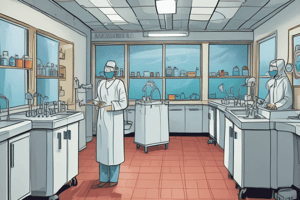Podcast
Questions and Answers
What is the main principle of Universal Precautions?
What is the main principle of Universal Precautions?
- Only blood and certain bodily fluids are infectious
- All bodily fluids are non-infectious
- All bodily fluids are infectious (correct)
- Only known infectious bodily fluids are contagious
What is the primary route of entry for infectious agents into the body?
What is the primary route of entry for infectious agents into the body?
- Non-intact skin
- Mucous membranes
- Gastrointestinal tract
- All of the above (correct)
Why is hand hygiene an essential part of Standard Precautions?
Why is hand hygiene an essential part of Standard Precautions?
- It prevents only airborne infections
- It is an effective way to prevent infections transmitted during procedures (correct)
- It prevents only contact infections
- It is only necessary when handling bodily fluids
What is the final link in the chain of infection?
What is the final link in the chain of infection?
When should hands be washed according to Routine Hand Washing guidelines?
When should hands be washed according to Routine Hand Washing guidelines?
What factors determine whether an exposure to a pathogen results in infection?
What factors determine whether an exposure to a pathogen results in infection?
What is the primary reason for wearing gloves in a laboratory setting?
What is the primary reason for wearing gloves in a laboratory setting?
What does the term 'doffing' refer to in the context of laboratory safety?
What does the term 'doffing' refer to in the context of laboratory safety?
What is the primary route of infection for percutaneous exposure to bloodborne pathogens?
What is the primary route of infection for percutaneous exposure to bloodborne pathogens?
Why is it important to avoid hand-to-mouth activities in a laboratory setting?
Why is it important to avoid hand-to-mouth activities in a laboratory setting?
What is the primary purpose of a waste management system in a laboratory setting?
What is the primary purpose of a waste management system in a laboratory setting?
What type of personal protective equipment is recommended for handling broken glass in a laboratory setting?
What type of personal protective equipment is recommended for handling broken glass in a laboratory setting?
What is the primary function of an infection-control program in a healthcare setting?
What is the primary function of an infection-control program in a healthcare setting?
What is a common portal of exit for a pathogen from a human reservoir?
What is a common portal of exit for a pathogen from a human reservoir?
What is the role of screening employees in an infection-control program?
What is the role of screening employees in an infection-control program?
What type of reservoir can include soil, water, and food?
What type of reservoir can include soil, water, and food?
What is the primary goal of a mode of transmission?
What is the primary goal of a mode of transmission?
What is the purpose of evaluating and treating health workers who have been exposed to infections?
What is the purpose of evaluating and treating health workers who have been exposed to infections?
Flashcards are hidden until you start studying




